Deborah J. Ross's Blog, page 147
May 24, 2012
Eclipse Diary, Part 3 – Ring of Fire

Deborah's attempt to photograph the eclupse (far right)
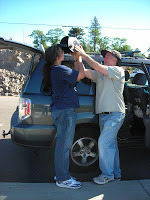
Photographing through a welding visor
The solar system is mostly empty space with leeetle teeny objects hurtling round a star (and some of them, around others) that, while quite medium and ordinary by galactic standards, is by far the largest, most massive object anywhere around. So Earth is hurtling around the Sun, the Moon is hurtling around Earth (and therefore, around the Sun in a sort of perambulatory – not a correct astronomical term, I believe – fashion). And every once in a while, the Moon comes between the Sun and the Earth, thereby blocking the sun’s rays and casting a shadow over a leeetle teensy area of Earth’s surface. Sometimes the disk of the Moon obscures the Sun – that’s a total eclipse, and in the area of the resulting shadow, there’s no sunlight, so it appears to be night – but, because the Moon isn’t always the same distance from the Earth and objects appear smaller when they are farther away, at other times, they line up but a ring of Sun remains – an annular eclipse. And because the lineup has to be exact for either of these to happen, the shadow cast by the Moon falls on only a small area of Earth. Hence, our journey to Lassen Volcanic National Park. (My husband stayed at home and got to see a partial eclipse.)
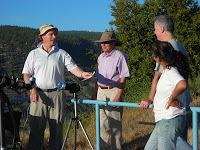
Astronomer Explains His Strategy
Once we’d established ourselves in a suitable viewing area, hoping fervently that the clouds we’d seen earlier would remain cooperatively absent, the countdown began. Solar eclipse shades are very cool things, if a bit hokey. They’re cheaply made, like glasses used for 3-D movies, but the film has to cut out all the harmful rays from the Sun in order to allow direct viewing, so everything else looks utterly black. I’ve spent my lifetime Not Looking Directly At The Sun, so at first it was odd (to say the least) to put on these black-out shades and do just that. The Sun appeared as the single luminous object in a field of black.
And then…a tiny dimple appeared in the orange disk.
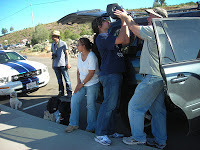
Eclipse Tailgate Party
At first, I wasn’t sure I hadn’t hallucinated it. Or that it was an effect of what happens when I blink wearing my contact lenses (which ride very high on my corneas, so there’s a moment of distortion until they settle back into their proper position). But no, there it was. And a few minutes later, there it was-with-attitude. To say I’d never seen anything like it is an understatement. I’d seen movies in which eclipses were portrayed via special effects. I’d seen pictures and photos and diagrams. But this…I was seeing this with my own eyes and it was happening right now. It wasn’t in a book or a film, it was the actual real event. Instead of looking at a two-dimensional image, I was intensely aware of the vast spaces, of stars and planets and moons in their orbits, of the physics of light (what little I understand of it). The cosmos isn’t just something on a television program, it’s out there for real. Most of the time, my scope of vision (physical vision, not imagination) is so limited. This was a glimpse of how big (and how amazing) our tiny corner of the universe really is.
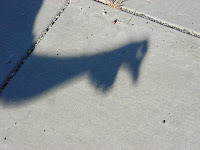
Pinhole Shadow Puppet (crescent "eye" is Sun)
So we watched as the nibble in the Sun grew larger. Jokes about the Cookie Monster abounded, as well as discussions about whether that was two-thirds or three-quarters. As the Moon covered more of the Sun, the quality of the light changed. Although the Sun was still quite high in the sky, it felt like twilight approaching. The temperature fell and a breeze sprang up. We speculated on how the birds would react to the full eclipse. People who did not have solar shades used various methods to observe the eclipse. The most fun of these were variations on the pinhole method (you hold up a piece of paper or similar materials with a tiny hole punched in it, and the sunlight coming through will cast an image on the surface of a screen (or sidewalk). You can also create a “pinhole” using the ventilation holes in a hat – or your hands. We made quite a lot of shadow puppets with crescent sun-images.
The Sun had become a fat crescent and then a thin one, and finally we could see the shape of the Moon as a complete circle. A hush fell over our little group as the place where the Moon had first impinged on the Sun began to glow. A complete ring appeared, and through the solar shades, both the central Moon and the surrounding sky were utterly black. People cheered and then hushed.
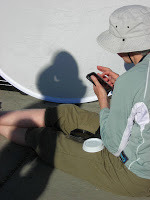
Using a Hat as a Pinhole Camera
The full eclipse lasted about four minutes. I spent almost all that time looking at it (as opposed to checking every few minutes during the occlusion). At one point, perhaps a minute into the fullness, it appeared to me like the One Ring from Tolkien’s The Lord of the Rings, hanging there above us all. No flaming eye made its appearance, thank goodness. The few times I lowered my shades, I noticed that even that thin ring of Sun was enough to make it day. Our shadows had doubled edges, though.
The four minutes passed all too quickly, and then the ring at the far side of where the Moon had first appeared began to thin and then to disappear, and the Sun became a thin crescent, and then a fat one. The “reveal” was much less momentous than the occlusion and seemed to go faster. I think the effect was psychological rather than astronomical, and perhaps we were all still in a state of awe from viewing the Ring of Fire.
At least, I hope I was.

Published on May 24, 2012 01:00
May 23, 2012
Eclipse Diary, Part 2 – A Community of Sun-Gazers
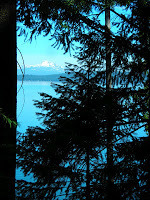
Mt. Lassen from Lake Almador
This is the second part of my solar eclipse adventures, accompanied by my intrepid neighbor and walking buddy, Chris.
Today’s lesson, young grasshopper, is that things turn out the way they do, no matter how different that is from how you expect them to be. All the information we had been given was that the best place to view the annular solar eclipse was from Lassen Volcanic National Park, plus there would be an educational presentation at the Information Center auditorium. Life, however, does not always follow what is given out in magazine articles and websites. When, after a morning of hiking around Lake Almador, we arrived at the park entrance, a long line of cars awaited us. The time for the presentation approached, with almost no forward progress. At last, when the entrance kiosk came into view, a Park Ranger informed us that not only was the parking lot full, or about to become so, but that we would not be able to view the entire eclipse from the park. She advised driving to Redding, about 90 miles away. She mentioned the Mineral Vista Point, considerably closer, but thought that the parking area might already be full.
In the tiny town of Mineral, we stopped to chat with the proprietors of the all-purpose lodge/market/general store. A number of people who’d turned back at Lassen had clearly decided that the way to view the eclipse was from the café patio, a cold beer in hand. They didn’t seem to mind that there were some rather large hills to the west. We, on the other hand, decided to try the Vista Point, reserving the lodge parking lot as a backup plan.

Eclipse Tailgate Party
When we arrived at the Vista Point, some 10 miles down the road, the formal parking areas were full, but we nabbed a shady spot off the road. I suspected that we would be only the first of many to park there, and I was right. We found an astronomer setting up a telescope and camera with special solar lenses. Before long, we’d struck up conversations not only with him, but his physicist friend and wife, and a family from San Jose. (I confess, I broke the ice here when I noticed the teen wearing a shirt saying, “Bow Ties Are Cool,” and began a Whovian conversation, during which Chris – who is an ardent Trekkie – entered into a spirited debate with the young man on the relative merits of DS9 and TNG, therefore imbuing the viewing with the flavor of a gathering of fans.) That family had brought a welding visor, and father and son busily figured out how to take photos of the eclipse through the visor glass plus the eclipse glasses.
I’d had quite a time getting solar eclipse shades for Chris and me. I’d ordered them online from an outfit that shall remain nameless about two weeks before we needed them. After one week, they still had not been shipped, so I emailed them to cancel the order and called Edmund Scientific. A real person was not only able to make sure what I wanted was in stock, but a shipping method that would ensure they arrived before we left. (This is a plug for Edmund Scientific – they delivered on their promise!) As it turns out, the first order arrived the day after we left, making it useless to us but very convenient for the members of the Quaker meeting of which my husband is a member, for he freely distributed them – the eclipse in that area was partial, but at least they could watch it safely.

Astronomer Charts A Course
After that, it should come as no surprise the number of people who’d arrived without eye protection or who had counted on being able to buy the glasses at the park. (The park, of course, had been sold out days before.) I’d brought 3 pairs, one for each of us plus a spare, and we passed them around, making sure that everyone got a chance to safely view the progress of the eclipse from time to time. There was a party at the end of the parking lot, older people who’d set up lawn chairs and tables, and were drinking wine and chatting, with not a single pair of shades in sight. As the Moon began to move across the Sun (taking a “bite” out of the golden cookie, as it were), I went over to offer a peek through my shades. “Oh, is it starting?” one of the women asked. “Look and see,” I said. So she did, exclaiming in delight.
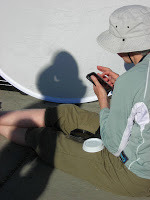
Using A Hat For A Pinhole Camera (note the crescent sun!)
There was fun and there was awe. The awe part goes in the next chapter of the diary, but the fun was being with people who quickly ceased to be strangers. Some were very knowledgeable, like the physicist, who not only set up a pinhole viewer but demonstrated how to create an image through the ventilation holes in his hat. I think the most moving sight of the viewers was a woman quadriplegic on a gurney, and the attentions of her husband in making sure she could see safely. (He also took the best photographs of any of us, except for the astronomer.)
We shared solar shades, we shared snacks, we shared knowledge and geekery. We shared kindness and wonder. And then, after a couple of hours, we all went away.

Published on May 23, 2012 01:00
May 21, 2012
Eclipse Diary, Part 1: Anticipation and Entitlement

Deborah's attempt to photograph the eclipse
To begin with, I did not intend to make a journey – a
pilgrimage – to see the May 20 annular solar eclipse. The reason is not that I
am indifferent to such a spectacle, but that for a long time, I have operated
under the principle that if seeing the wonders of the sky – or any other
wonders – involves expense or training or any significant break in the daily
work routine, then I am not entitled to it. I suspect this attitude – what my
husband teasingly refers to as my “poverty consciousness,” stems from being the
child of working class parents who came of age in the Great Depression, and who
as a young person myself rarely had much disposable income. What I did not
understand then, and am coming to understand as I get older, is that life is an
adventure to be lived, not scrimped through. Some years back, I had to make a
choice between returning to school for training that would take all my time and
energy for several years with the end result of earning a modestly comfortable
living, or to keep on at my current day job and being able to write. I had to
ask myself, what is really important? Being able to buy new clothes instead of
picking through thrift stores? Or sailing on my dreams, spinning out the stories
that are in me to tell? I picked the dreams, and I have never regretted that
choice. It changed me, of course, not just the writing but the very realization
that as far as I know, I will only go through this life once. The world and the
heavens are full of mysteries and glory, just waiting for me to look.
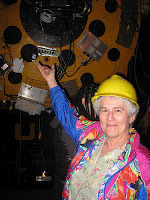
At Wyoming Infrared Observatory, 2011
Studying astronomy had been somewhere on my list. I call it
a “wistful list,” or maybe a “wishful list,” not a “bucket list.” The litany
went, Someday when I have time…but Cabrillo College is a 45 minute drive away…
but the classes are at night and night-time driving in the mountains is
exhausting… but… but…” Then last spring I saw an announcement for Launch Pad
Astronomy Workshop, a one-week intensive course for science fiction writers
held at University of Wyoming Laramie, created and directed by astronomer/sf
writer Mike Brotherton, and funded by NSF. “They’ll never take me,” I thought,
“I write fantasy these days.” But it’s just as important for fantasy (and
horror, and Romance, and thriller, and mystery writers) to get the science
right. So I applied.
They accepted me. I danced around the house, whooping with
delight. That summer, I proceeded to get my brains stuffed with amazing facts
and ways of looking at the universe; I met fantastic writers and scientists,
and shared their passion for exploring – by telescope, space shuttle or
imagination – beyond the borders of our home planet. Every day, my mind was
filled to overflowing with story ideas and incredibly nifty data; at night, we
gazed at the stars for ourselves. If I had not been willing to take that
chance, to say, “Hey, what about me?” then I would have missed out on so much.
Fast forward a year, and I see on the astronomy and science
websites that I now subscribe to that there will be an annual eclipse of the
sun (one in which the occlusion is incomplete, so there remains a “ring of
fire” around a dark central shadow), visible not too far away (but too far to
drive and then return home easily in the same day). The old “poverty
consciousness” voices began their murmuring. Never mind that this is the
closest I’d be able to see a solar eclipse from (or that it doesn’t involve
staying up until 3 am, another bugaboo that assumes more importance as the
decades pass). My neighbor and walking partner said, “I’ve booked a motel room
near Lassen so I can go up and see the eclipse, and I’m looking for someone to
share the room.”
And the world stopped.
I thought, “I’m 65 years old and I’ve never seen a solar
eclipse. Chances are, I will never have another opportunity, at least not one
so close and so convenient. Not to mention the congenial company. It would be
an awful shame – no, an outright crime – to let a couple of hundred dollars
become an insurmountable obstacle. If the credit card bill isn’t paid off by
the time I die, at least I will have seen an eclipse.”
She arranged for the motel room. I obtained the solar
eclipse shades. We shared the driving.
Stay tuned for what happened next...
An abbreviated version of this diary series appears in Book View Cafe blog Tuesday, May 22.

Published on May 21, 2012 22:31
May 19, 2012
Coming Soon -- Eclipse Journal
Shortly, I'll be off, driving with a friend to Lassen Volcanic National Park to view the annual solar eclipse tomorrow. I'll be blogging about my experience, beginning Tuesday.
Stay tuned!

Stay tuned!

Published on May 19, 2012 09:28
May 16, 2012
GUEST POST: Julianne Lee on Time Travel
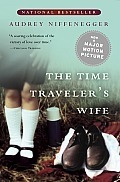
I adore time travel stories. As far back as H.G. Wells and
Mark Twain, the concept of time travel has given us the opportunity to examine
how things change and how they stay the same. It is the ultimate
fish-out-of-water scenario, and it’s one of my favorite to write because the
possibilities are limitless.
Nearly any type of story can involve time travel. Take, for
instance, “The Time Traveler’s Wife” by Audrey Niffenegger, which is one of the
most romantic stories I’ve ever read. Henry DeTamble, somewhat like Kurt
Vonnegut’s Billy Pilgrim in “Slaughterhouse Five,” becomes unstuck in time and
spends his life shifting back and forth between present, past and future.
Sometimes knowing what will happen, and yet never knowing when, Henry examines
his life from a rare perspective. But “The Time Traveler’s Wife” is not
categorized as science fiction, or even fantasy. Nor even romance. And that, to
me, is a good thing. All fiction should be fluid of genre.
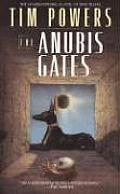 In writing stories of time travel, the field of genre can be
In writing stories of time travel, the field of genre can bequite open, but I believe there are certain rules that must be followed, for
the same reasons we adhere to spelling and grammar conventions. It aids
communication. Not so much to be rigid about tropes, but for the story to make
logical sense. As in any world building, regardless of genre, consistency is key.
Of course I have my preferences, and I’ll say right here
that Tim Powers’ “The Anubis Gates” is my bible. Powers begins with a mystical
time transport mechanism and lays it over a quasi-scientific approach, and
makes us believe his premise, which is that there are time portals that can be
used to the advantage of those who know about them. The story is deliciously
convoluted, yet it is so perfectly consistent internally that the reader can
trust the world that has been built. Suspension of disbelief is effortless.
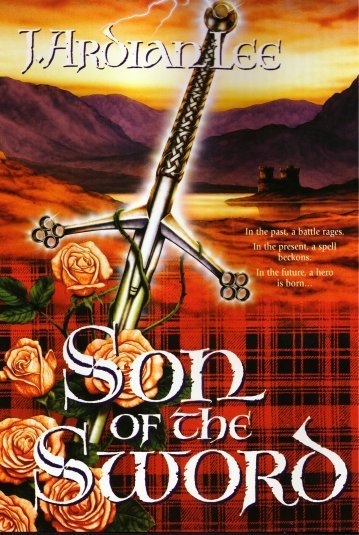
In Powers’ work, history does not change. That is, the story
established at the beginning of the book is not changed by the actions of the
time-traveling characters. That is the choice I also made in my first series,
in which my main character, Dylan Matheson, is swept back in time to fulfill a
destiny that had happened long before he was born. Quite the opposite of what
was intended by the Scottish faerie who had brought him there.
That is not to say that changing history is an inherently
bad idea. Sometimes the story depends on history changing, which points out the
interdependence of cause and effect. The concept of Butterfly Effect, though a
mediocre movie, is a wonderfully broad area of exploration. But there are
warning signs on the road up ahead. Changing the story makes for a complexity
of cause and effect that can be disastrous. If the past is changed, then can
the time travel have happened in the first place? It’s the classic paradox: if
I travel back in time and kill my grandfather, how could I have been born to
travel back in time to kill my grandfather? Often it’s good to steer clear of
that particular paradox unless you’re trying to solve it. And best of luck with
that.
[image error]
Only one of my time travel stories changes history. “Kindred Spirits” involves a woman who is transported to the American Civil War by a
spell she recites from an old diary. Late in the plotting process I realized
that in changing the past I had removed the mechanism by which Shelby traveled
to it. To fix that problem, I very carefully reconstructed the plot so that the
mechanism remained and there was no paradox. Even so, there were still some
things that appeared to be paradoxes. It required careful reading to follow
both timelines and know where they diverged. Some readers follow it, and some
don’t.
I also like to avoid making a character his own ancestor.
Besides introducing a cause and effect paradox, I think it’s a little creepy no
matter how far back in the family the character is introducing himself.
The best handing of this I’ve ever seen was in the movie
“The Terminator.” In one of the tightest screenplays I’ve ever seen, time
traveler Kyle Reese arrives in present day to save the mother of his mentor, John
Connor, and in the process becomes John’s father. Maybe not a surprise (“Tell
me about my son.” “Well, he’s about my height...”), but very, very cool.
The last and not least important thing in writing time
travel is to decide on the mechanism and stick with it. Decide where the
portals are in both time and space, why they work, and how much control the characters have over
them. If the portals travel in time, make them consistent and explain why they
travel. If a character enters a portal at X time and travels back twenty years
to Y time, spends three days and then travels back to X time plus three days,
explain why the X portal has moved in time and the relationship between X and Y.
Or, even worse, if the character travels again to the Y portal, if the Y portal
moves it should be consistent with any movement of the X portal, and should be
explained. And adding portals late in a series should be well supported and not
done willy-nilly in either time or space. Indulging in hand-waving and making
vague mutterings about “wormholes” doesn’t cut it. This is basic
world-building, and changing the rules late in the game just isn’t fair to the
reader. Be clear and consistent.
These are some of my favorite things: Quantum Leap; A
Connecticut Yankee in King Arthur’s Court; The Terminator; The Anubis Gates;
Time and Again; Somewhere in Time; 11/22/63; ...well the list is too long for
this essay. I love time travel, and will read just about anything involving it.

About Julianne Lee: At twelve I began to write for fun, which I think is the only real
reason to write fiction. Daydreaming with a purpose, and gradually I
realized I could gain approval for the very thing teachers used to
criticize me for in class. When I was thirty I decided to write for
money and bought a copy of Writer’s Digest.
Twelve years, twelve completed novel manuscripts, and eight proposals for uncompleted novels after buying that Writer’s Digest, I sold a novel. Son of the Sword was my thirteenth completed manuscript. Lucky thirteen. Since then
Berkley has published two time travel series set in historical Scotland,
and two straight historicals set in Tudor England. I also write
historical mysteries set in Restoration London, under the pseudonym Anne
Rutherford.

Published on May 16, 2012 13:37
May 14, 2012
The Feathered Edge: Desire in Florence
Italy has some of the most romantic and mysterious cities in the world, and I was delighted when Jay Lake and Shannon Page sent me a story set in the Renaissance Florence.

Florence, by Thermos

Venice, by Paolo da Reggio
My own adventure began in 1991, when I was living in France. We used our children’s spring break to visit Italy, and that meant Florence and Venice. These places overwhelmed me with a sense of being not quite in the same reality as other places I’d been. I was accustomed to living near water (having come from Venice, California -- all right, just across the street from the Venice city line), but not the pervasive sense of dark, fluid depths underlying every building and every walkway, nor the atmosphere of age and history, or the constant reminders of private lives – of secrets – behind those shuttered windows and doors. Whether strolling through the piazzas or over one of the many bridges, or riding in a gondola, or sitting in a café, I felt myself surrounded by stories. I remember the moment of awe when I stepped out into the plaza of the ghetto (the original ghetto, after which all others are named). There isn’t much to see, just a well-swept space surrounded by tourist shops; it’s not what I saw but what I felt, century upon century of hope and despair, of huddled safety and wellsprings of determination.
A tourist brochure, perhaps from the city of Venice itself, I can’t remember now, featured images from carnevale. One of these was the famous character, Bauta. This costume consists of a unadorned white mask, flared at the bottom where the mouth should be, a black tricorned hat, and a black cloak. It is impossible to tell if the person wearing it is old or young, man or woman, rich or poor – a true disguise for that brief time of merry-making when such distinctions no longer hold sway. In the publicity image, indirect, diffuse lighting cast the figure in mysterious shadows. You can see something of what it looked like
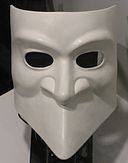 Or
Or
Oh my, I thought. Story material.
When I returned to the US, I pinned the picture on my bulletin board beside my computer. Although I worked on other projects, my eyes kept drifting back to this enigmatic, slightly menacing figure. I had a chance to take some of those shivers and weave them into a story when I was invited to submit to an anthology of historical fantasy, Ancient Enchantresses, edited by Kathleen M. Massie-Ferch. I based my story, "Unmasking the Ancient Light," on the life of Dona Gracia Nasi, one of the most extraordinary Jewish women of the Renaissance. My friend Bauta did not put in an appearance in my story, but furnished a wealth inspiration for an ancient, brooding menace.
Then, as I was reading stories for The Feathered Edge: Tales of Magic, Love, and Daring, I opened the one Jay and Shannon had sent me and read:
Firenze, 1498
I peered around the rough-edged corner of the Palazzo Martelli, searching down the long, night-shadowed lane but seeing nothing save the muddy path to the river Arno below. The Ponte Vecchio glimmered in the distance, lit by a single torch at the near end.
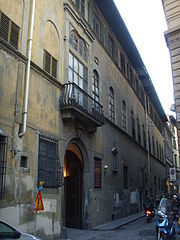
Palazzo Martelli, by sailko
Oh my. Italy, again!
And what a marvelous time this is! Florence is ancient and brooding, but infused with the vigor of magic, of a living, working city, not a vacation destination. This is not the Florence of picture postcards and tourist brochures. Dangerous things lurk in waters, and watch you from the rooftops…and behind the gaity and mercantile riches, a battle is being waged, one whose stakes are hearts as well as souls. Jay and Shannon weave the vivid details into an erotic tale of desire, sorcery, and power.



Florence, by Thermos

Venice, by Paolo da Reggio
My own adventure began in 1991, when I was living in France. We used our children’s spring break to visit Italy, and that meant Florence and Venice. These places overwhelmed me with a sense of being not quite in the same reality as other places I’d been. I was accustomed to living near water (having come from Venice, California -- all right, just across the street from the Venice city line), but not the pervasive sense of dark, fluid depths underlying every building and every walkway, nor the atmosphere of age and history, or the constant reminders of private lives – of secrets – behind those shuttered windows and doors. Whether strolling through the piazzas or over one of the many bridges, or riding in a gondola, or sitting in a café, I felt myself surrounded by stories. I remember the moment of awe when I stepped out into the plaza of the ghetto (the original ghetto, after which all others are named). There isn’t much to see, just a well-swept space surrounded by tourist shops; it’s not what I saw but what I felt, century upon century of hope and despair, of huddled safety and wellsprings of determination.
A tourist brochure, perhaps from the city of Venice itself, I can’t remember now, featured images from carnevale. One of these was the famous character, Bauta. This costume consists of a unadorned white mask, flared at the bottom where the mouth should be, a black tricorned hat, and a black cloak. It is impossible to tell if the person wearing it is old or young, man or woman, rich or poor – a true disguise for that brief time of merry-making when such distinctions no longer hold sway. In the publicity image, indirect, diffuse lighting cast the figure in mysterious shadows. You can see something of what it looked like
 Or
Or Oh my, I thought. Story material.
When I returned to the US, I pinned the picture on my bulletin board beside my computer. Although I worked on other projects, my eyes kept drifting back to this enigmatic, slightly menacing figure. I had a chance to take some of those shivers and weave them into a story when I was invited to submit to an anthology of historical fantasy, Ancient Enchantresses, edited by Kathleen M. Massie-Ferch. I based my story, "Unmasking the Ancient Light," on the life of Dona Gracia Nasi, one of the most extraordinary Jewish women of the Renaissance. My friend Bauta did not put in an appearance in my story, but furnished a wealth inspiration for an ancient, brooding menace.
Then, as I was reading stories for The Feathered Edge: Tales of Magic, Love, and Daring, I opened the one Jay and Shannon had sent me and read:
Firenze, 1498
I peered around the rough-edged corner of the Palazzo Martelli, searching down the long, night-shadowed lane but seeing nothing save the muddy path to the river Arno below. The Ponte Vecchio glimmered in the distance, lit by a single torch at the near end.

Palazzo Martelli, by sailko
Oh my. Italy, again!
And what a marvelous time this is! Florence is ancient and brooding, but infused with the vigor of magic, of a living, working city, not a vacation destination. This is not the Florence of picture postcards and tourist brochures. Dangerous things lurk in waters, and watch you from the rooftops…and behind the gaity and mercantile riches, a battle is being waged, one whose stakes are hearts as well as souls. Jay and Shannon weave the vivid details into an erotic tale of desire, sorcery, and power.

Published on May 14, 2012 17:04
May 8, 2012
Exercise and the Older Writer
Today's blog post is an excerpt from my post on Book View Cafe. We're doing a series on "Citius, Altius, Sapientius," ("Stronger, Faster, Wiser," according to our resident Latin scholars). I've been struck many times over the years with how many writers are also martial artists, dancers, runners, horse people, mountain climbers...and, as we age, students of yoga or tai chi chu'an. Is there more to this than the simple need to get up and stretch once in a while? And what can we learn from one another about staying strong, flexible, and energetic throughout our creative careers?
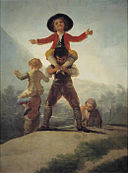 It seems that the older I get, the more integral exercise is to my writing practice. The way they are interwoven has
It seems that the older I get, the more integral exercise is to my writing practice. The way they are interwoven haschanged with the passing decades, as has the type of physical activity
that appeals to me. I no longer exercise to change my appearance (not
that this ever was a huge motivation, but I think all young people have
at least some small measure of physical vanity). I think more about
staying healthy and maintaining the strength and flexibility that allow
me to do other things I enjoy — like sitting comfortably while I write,
exploring new places…having adventures. First and foremost, however, I
like things that are fun. So I’m not going to give you a litany of all
the reasons you should exercise to prevent heart disease or stave off
Alzheimer’s. I’m going to talk about the ways being active have made me a
better writer, in ways that I couldn’t appreciate when I was a newbie.
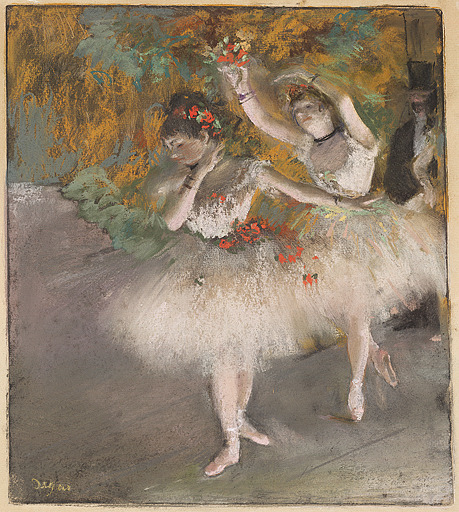 Once upon a time, I was an active kid. I didn’t think about exercise per se, I thought about playing.
Once upon a time, I was an active kid. I didn’t think about exercise per se, I thought about playing.I ran through sprinklers, I rode my bike and attempted to roller-skate,
I played outdoor games with my friends — tag, Red Rover, hopscotch,
Simon Says, jumprope and ball-bouncing games, running around with
dogs…but best of all, I acted out the stories I made up, either with my
friends or by myself. I think this was my first and foundational
experience of how glorious, how unexpected and consuming and enriching
story-telling might be. As kids, we threw ourselves into one adventure
after another. Granted, much of it was derivative, a sort of live-action
fanfic. What we could do physically — climb trees, build snow forts,
crawl under bushes, sneak around buildings — we did, and the rest we
mimed as best we could. Stories were experienced not just with words,
but with our whole bodies.
As readers, haven’t we had the
experience of feeling our heart rate accelerate and our muscles tense
during a particularly gripping or suspenseful scene? Our visceral
reactions intensify the action, helping to link us to the characters and
their plight. So many times, I’ve read a passage that skillfully
depicts some action and thought, I know what that feels like. I’m in
that character’s shoes, or riding boots, or skin-diving flippers, or
crampons, or toe shoes.
Read the rest of it on the Book View Cafe blog.

Published on May 08, 2012 10:27
May 3, 2012
GUEST BLOG: Rayne Hall on Music For Writing Fight Scenes
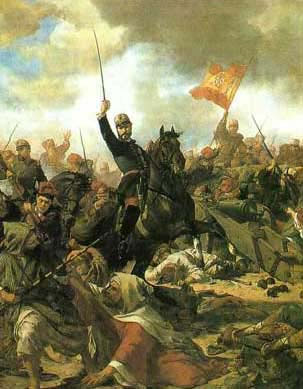
Whatever music you play in the
background affects your writing. It helps if it's instrumental, because lyrics
can be distracting. Try to find tunes
which suit the mood, culture, period or setting of your story.
Ideally, the music you play in the
background should have medium or fast tempo. The tempo of the music will affect
your heart rate as well as your subconscious. Fast, bouncy music leads to
fast-paced scenes, while ambient relaxation music can give your scene the pace
of a slug.
Consider burning a CD or creating a
playlist for every WiP, or better still, for every scene.
Is Harry Hero about lead his loyal
henchmen into battle against the Forces of Evil? Will Helga Heroine defend her
virtue against Vicious Vince?
Put on fast music, and the fight will
practically write itself.
Here are some of the tunes I play while
writing fight scenes. At YouTube, you can listen to them for free. Just don't
be tempted to watch the clips when you should be writing.
* Sabre Dance by Aram
Khachaturian. Very fast, exciting, perfect for sword or dagger fights.
* The final of the overture
to the opera William Tell (aka Wilhelm Tell aka Guillaume Tell)
by Giaochino Rossini. Very fast, great for cavalry charges.
* Ceddin Denden , a
traditional Turkish military song. Medium tempo, good for historical fiction.
* Walkürenritt aka Rideof the Valkyries by Richard Wagner. Dramatic and intense, good for final
showdown fights at the climax of the novel.
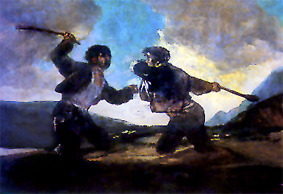
* Unstoppable by E.S. Posthumus. Dramatic, good for realistic,
gritty, violent scenes.
* Kafkas Lezginka
(aka Kavkas Lezginka), a traditional tune from the Caucasus, used for
ultra-masculine folk dance performances. Good for dagger and fencing fights.
* 40 Göktürklü. Soundtrack from a Turkish historical movie. Good
pace, steady bouncy rhythm, some singing.
* Seyh Samil aka Sheik
Shamil aka Seyx Schamil and various other spellings. A famous folk
song from the Caucasus and the Middle East, celebrating the heroism of a
historical resistance leader. This is an instrumental version with a steady
rhythm.
You can also listen to military
marches, which generally have a steady medium-to-fast rhythm. However, their
exuberant mood is designed to make soldiers happy about going to war and does
not reflect the brutal reality of battles.
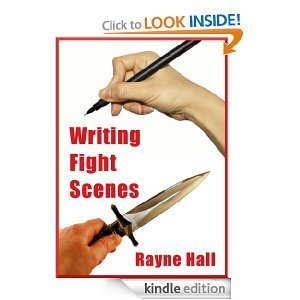 Movie soundtracks, especially from
Movie soundtracks, especially fromfight scenes, are often dramatic and intense. Although they lack the steady
rhythm most authors need for writing, they're great for plotting and sure to
get you into the mood.
Put on music – apply fingers to
keyboard – write!
Rayne Hall is the author of thirty books in different
genres and under different pen names, published by twelve publishers in six
countries, translated into several languages.She teaches online craft classes for advanced
and professional writers (Writing Fight Scenes, Writing Scary Scenes,
Writing about Magic, The Low-Word Diet and more).
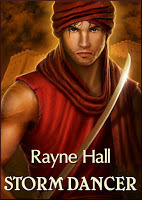
Recent releases under the Rayne Hall pen name:
“Storm Dancer” (dark-heroic fantasy novel)
“Six Scary Tales Vol 1”, “Six Scary Tales Vol2”, “Six Scary Tales Vol 3” (short horror stories)
“Writing Fight Scenes” (Practical step-by-step
instructions how to make your fictional fights realistic and exciting.)
Recent multi-author anthologies edited by Rayne
Hall:
“Haunted: Ten Tales of Ghosts”
“Bites: Ten Tales of Vampires”
“Cutlass: Ten Tales of Pirates”
------------------------------------------------------------
The first painting is by Francesc Sanz i Cabot: The General Juan Prim y Prats at the Battle of Tetuan, which occurred on 4 February 1860. The second is by Francisco de Goya, La rina c. 1819, both in public domain.

Published on May 03, 2012 01:00
April 28, 2012
SPECIAL GUEST BLOG: Katharine Kerr on Good Prose
Writers and readers both love to discuss, and maybe argue
about, what constitutes "good" prose. From the readers' points of
view, the definition really comes down to a matter of taste -- at least, that’s
the conclusion I usually end up drawing from these discussions.
Some people enjoy complex sentences and unusual words.
Some people hate them. Some people hate short sentences and basic vocabulary. Others
like them. And so on.
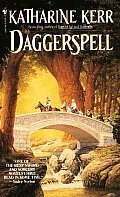
It occurred to me that we might look at the problem from
the other side: the writer's point of view. What constitutes good prose? Prose
that has the effect upon the reader that the writer intended it to have.
Does the writer want the reader to zip through the story
and enjoy it as an entertainment? That will require one style of prose. Does
the writer want the reader to experience the story as an immersion into a
strange and foreign place and time? That will require another. Is an incident
supposed to be funny? Humor demands a certain choice of words. Is the incident
supposed to make the reader get all teary-eyed? Then the writer had better
avoid that distanced, ironic humor.
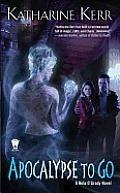 We can thus define "bad" prose as words that
We can thus define "bad" prose as words that
fail to do what the writer wants them to do. Really bad prose which is so
muddled that we can't even tell what the writer had in mind does exist, but
such doesn’t get into print. Usually the examples are less extreme. A
strict-genre entertainment might be written in such complex, rambling sentences
that a reader looking for a few hours of escape decides to throw the book across
the room. A thoughtful, serious near-future SF work that sounds like a middle
grade adventure story is not going to get much respect.
Here's an example of how bad prose can wreck a story, one
I remember from a writing class of many years ago. I've forgotten the writer's
name, and I bet he'd be glad I have. Anyway, the story concerned a Sensitive,
Poetic Young Man who yearned for a certain girl at a high school dance. He asks
her to dance, she makes fun of him, his pain knows no bounds. The reader does feel
his pain and feels sorry for him until he rushes out of the dance into the
parking lot, where :
"In the glare of floodlights the pale trunks of the
eucalyptus trees looked like cottage cheese."
That, folks, is mood-shattering prose.
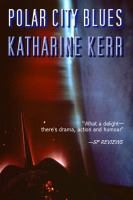
Katharine Kerr is the author of too many weird books,
including the multi-volume Deverry cycle of epic fantasy, a few SF works, and
the new Nola O’Grady series of urban fantasies. She lives near San Francisco,
CA, with her husband and some cats.
Polar City Blues is now available as a multi-format ebook from Book View Cafe.


about, what constitutes "good" prose. From the readers' points of
view, the definition really comes down to a matter of taste -- at least, that’s
the conclusion I usually end up drawing from these discussions.
Some people enjoy complex sentences and unusual words.
Some people hate them. Some people hate short sentences and basic vocabulary. Others
like them. And so on.

It occurred to me that we might look at the problem from
the other side: the writer's point of view. What constitutes good prose? Prose
that has the effect upon the reader that the writer intended it to have.
Does the writer want the reader to zip through the story
and enjoy it as an entertainment? That will require one style of prose. Does
the writer want the reader to experience the story as an immersion into a
strange and foreign place and time? That will require another. Is an incident
supposed to be funny? Humor demands a certain choice of words. Is the incident
supposed to make the reader get all teary-eyed? Then the writer had better
avoid that distanced, ironic humor.
 We can thus define "bad" prose as words that
We can thus define "bad" prose as words thatfail to do what the writer wants them to do. Really bad prose which is so
muddled that we can't even tell what the writer had in mind does exist, but
such doesn’t get into print. Usually the examples are less extreme. A
strict-genre entertainment might be written in such complex, rambling sentences
that a reader looking for a few hours of escape decides to throw the book across
the room. A thoughtful, serious near-future SF work that sounds like a middle
grade adventure story is not going to get much respect.
Here's an example of how bad prose can wreck a story, one
I remember from a writing class of many years ago. I've forgotten the writer's
name, and I bet he'd be glad I have. Anyway, the story concerned a Sensitive,
Poetic Young Man who yearned for a certain girl at a high school dance. He asks
her to dance, she makes fun of him, his pain knows no bounds. The reader does feel
his pain and feels sorry for him until he rushes out of the dance into the
parking lot, where :
"In the glare of floodlights the pale trunks of the
eucalyptus trees looked like cottage cheese."
That, folks, is mood-shattering prose.

Katharine Kerr is the author of too many weird books,
including the multi-volume Deverry cycle of epic fantasy, a few SF works, and
the new Nola O’Grady series of urban fantasies. She lives near San Francisco,
CA, with her husband and some cats.
Polar City Blues is now available as a multi-format ebook from Book View Cafe.

Published on April 28, 2012 01:00
April 26, 2012
Career "Roadbumps"
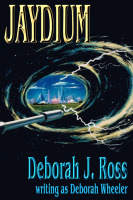
A couple of years ago, YA writer Janni Lee Simnr put out a call for the sharing of writerly tribulations and triumphs: So
I'm putting out a call for writers--at all stages of their careers--to
talk about the roadbumps, the setbacks, the rough times. Because we all
need to see that too, and too often we don't. And if we all do this at
the same time, maybe admitting to having imperfect careers will be less
daunting, too.
Here's what I wrote: I sold my first
professional short story in 1982, when my first child was small. It went
to an anthology, that turned into an annual event, and the editor
really liked my work, so for the next chunk of years, I'd write 2 or 3
shorts and a novel, would sell most of the shorts to that same editor,
zilch on the novels.
Then several things happened. I realized I
was in danger of becoming a one-editor writer for a fairly specialized
market. I joined a local writers group that had a bunch of Clarion grads
and other critique-skillful people. I'd networked enough at cons to set
a strategy for getting an agent: make up a dream list, get an offer,
call the agent at the top of the list.
The critique group tore
apart my current attempt at a novel. I went home, cried, screamed, set
aside my pride, came back, asked for one-syllable-word explanations,
worked my tail off on craft. Eventually, that book (the 6th or 7th I'd
written, depending on how you count partials/rewrites) became my first
sale. Got the offer (after a 2-year wait), called the agent of my dreams
-- hooray! Seems my writer friends had been telling him about me and
he'd been waiting for me to have a project he could represent. In the
meanwhile, I started selling shorts to top markets like ASIMOV'S, F
& SF, the second STAR WARS antho, and others. In other
words, I'd broken out of the one-editor trap.
Fast forward
through a poorly-selling 2nd novel, a decision to not change my
byline for the third (this was in the prelude to a personal meltdown
that lasted several years, so I was not exactly rational), then a long
dark stretch. Sold a few shorts, some of them among my best work, kept
slowly healing as I struggled with being a single working mom with a
troubled teen.
Then came one of those amazing breaks that
sometimes happen. The chance to work on a Darkover novel with Marion
Zimmer Bradley, a dear friend who'd stood by me through the hard times. I
don't have words for the gratitude for that boost back to writing
novels. I would have eventually gotten there, but it would have been
much, much harder.
Yes, there have been many frustrations since
then, trying to work in my original novels, endless delays with editors
(more 2-year waits, now on option books), no luck with several novels
written in the "gap" time. But just knowing someone believed in me --
enough to ask me to come play in her world -- still shines as a beacon
of hope in my life.
Now I edit as well as write, and occasionally get to be the beacon myself.

Published on April 26, 2012 01:00



